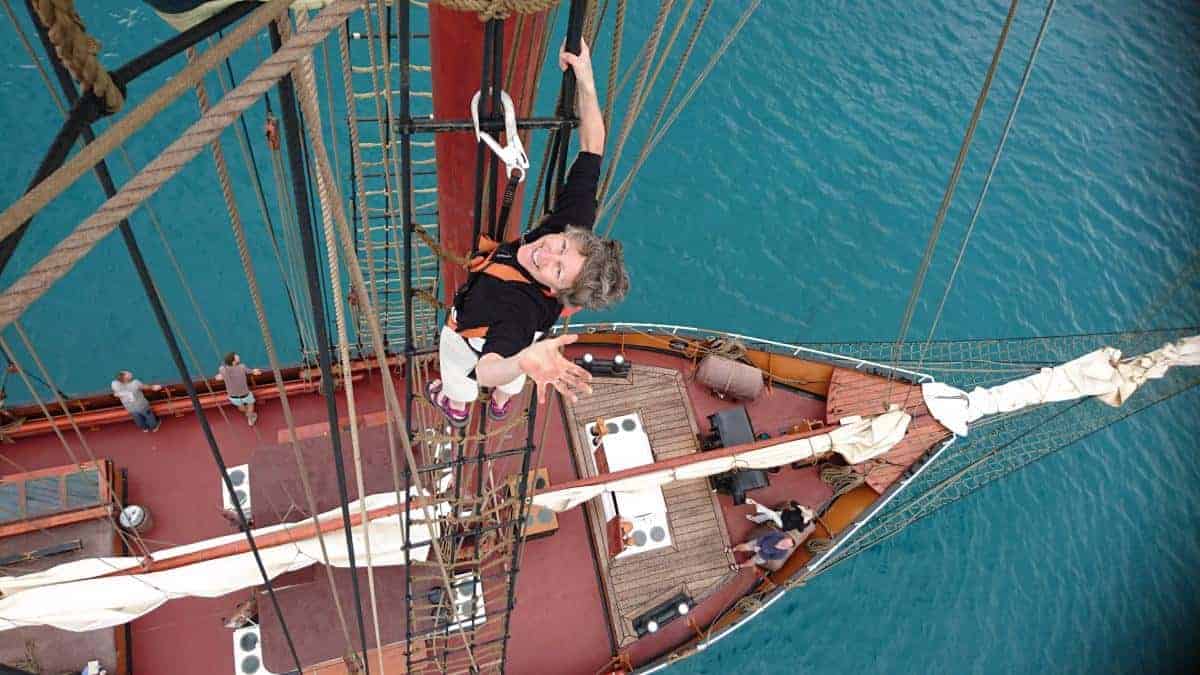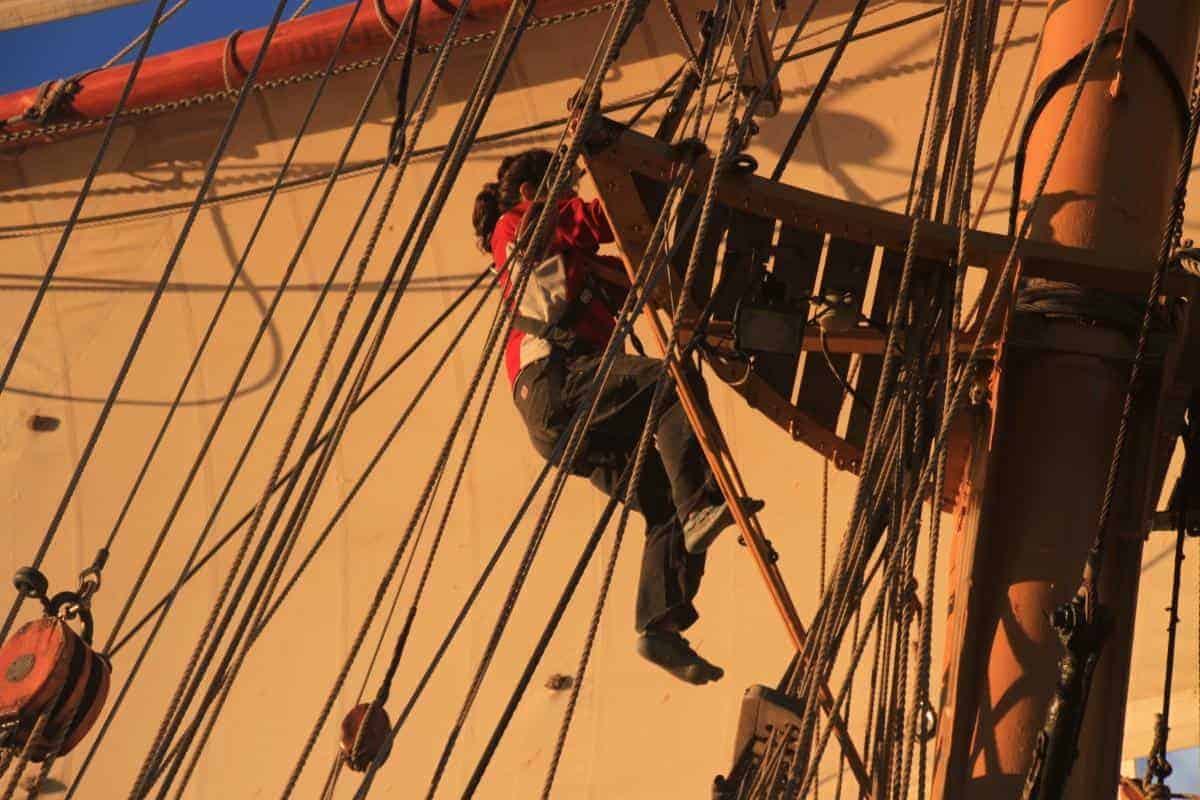On a tall ship voyage you will be encouraged to climb the rigging. If you enjoy it, this will be part of your job as working tall ship crew. It is never compulsory and you will have more than one chance to try it. We think to climb aloft at sea is one of life’s natural highs. The adrenalin buzz is huge, even if you have done it before, and the higher you get the easier it is to spot wildlife too.
Different ships have slightly different systems, but the usual is to climb freely for most of your ascent. If you get tired, need a break, get nervous or are stopping to do something, then you clip yourself securely to the standing rigging. For tricky parts of the climb (such as getting up and over the platforms) ships have safety wires installed. These allow you to clip on without your safety lanyard getting in the way of the maneuver. There are safety wires / jackstays on the yards too, so you can help stow square sails knowing you’re secure.
It is essential that the crew know who is aloft, and that anyone going climbing has been fully briefed. There will also be times when it would be dangerous up the rigging, so always check with a member of crew first.

How Agile do I need to be to Climb the Rigging ?
We have been working al for years and have seen all sorts of people climb the mast. This goes for everyone from 70 year old ex ballet dancers to 13 year old sea scouts. For someone of average fitness the challenge is about 75% mental and 25% physical.
Some make it by the end of a voyage to secure that all important ‘I did it’ photo. Others find they love their lofty perch and volunteer to go up at any opportunity. Everyone will have their own limit, whether its the lower shrouds or right up to the t’gallants. The crew will help you to push yourself just enough.
You don’t have to be slim to enjoy tall ship sailing. A bit of body weight applied to a rope with enthusiasm at deck level is much appreciated by your shipmates, and climbing can be mastered whatever shape you are.
There is plenty to learn and do at deck level if climbing proves not to be your thing. Finding the right ropes and understanding their purposes is just as important. If, by the end of the trip, you can understand the sequence of events for each sailing maneuver, you’re doing really well!

What do I Need to Know Before Climbing the Mast?
Whichever ship you’re on, you will need a climbing induction before you can shin up the rigging. Your first climb will be ‘buddied’, as an experienced member of deck crew will come with you. This is important, as not all the useful-looking hand-holds are safe to use. Many ships insist on a buddy system for all trips aloft. Ensure you listen carefully to the crew at all times when you are up the rigging. If you feel unsure about anything, always ask. There’s no such thing as a silly question!
Shrouds are the strong wires that hold each mast up; they’re often black and tarry! Ratlines are the horizontal rungs of the ladder strung between the shrouds. You climb by holding on to the shrouds and you treading on the ratlines like ladder rungs.
Some ratlines are solid wooden slats (‘ratbars’) rather than rope. These are nice and stable and a good place to take a pause if you need to. On most tall ships the ‘ladder’ at the bottom is wide enough for several people to climb side by side. This is great for your initial ascent as you can have a crew member beside you for the first section.
The angle of your ‘stairway to heaven’ is considerably less steep than most decorating ladders and a lot more secure. You always climb on the windward shrouds (side of the ship closest to the wind). This means you are being blown ON to the rigging, and if the ship has any heel (tilt) it will be in your favour.
When climbing, the main thing to remember is to keep three points of contact with the ship. Many are the stories of sailors using their teeth as a ‘point of contact’, but we would recommend you stick to your hands and feet! Move one. Make sure you’re secure. Move the next one. Smile! Once you’re out on the yards, you are securely clipped on. Kicking your legs back slightly, your tummy becomes a point of contact, leaving both hands free to work the sail.

Up & Over the Futtock Shrouds
The first big hurdle for most people are the infamous ‘futtock shrouds’ just below the first platform. There will be a safety wire here for you to clip to, so if you do slip you won’t go far. Getting round and up onto the platform does need a bit of arm strength and commitment as the futtock shrouds lean backwards for about 4-6ft. It can be daunting, but you’ll soon get the knack.
Let a crew member guide you at first, especially on the way down. If they can get below you and help direct your feet it’s a huge help. Everyone does this bit slightly differently, as everyone has different lengths of limbs! Take your time and you’ll find your way. It’s also good practice to lean back and keep your arms fairly straight. This is less tiring, makes it easier to see what you’re doing, and keeps your torso out of the way of moving hands and feet.

Out on the Yards
Stepping from the relative security of the ratlines on to a single wire foot rope slung under the yard is a bit unnerving but it soon becomes second nature. Before you step out on to the yard you clip your safety line to a horizontal wire. This jackstay runs the length of the yard, which means you can shuffle all the way to the end without having to think about unclipping or re-clipping. It’s considerate to shout ‘Stepping On’ and ‘Stepping Off’ before you get on and off the footrope. This allows anyone who’s already on the yard to hold on until any wobbling is finished!
The usual reason for going aloft is to get out on the yards. This will either be to untie the gaskets (sail ties) to get the sail ready for setting, or to stow the sail (pack it away). Stowing the sail needs a few more people, all working together to roll the sail up and secure it in its gaskets. Most of the weight is taken by the clewlines and buntlines, but furling squares can still be a bit of a fight, especially if it’s windy.
Have a go at untying the gaskets, or take an exploratory climb out onto the yard when its quiet, before you volunteer to help stow the squares. Stowing sails is the trickiest of the tasks out on the yards, and usually needs doing because the wind is picking up. It’s important that you feel fairly confident.
The further out from the mast you are, the wobblier it can feel. If you’re still a bit unsure, stay closer to the centre.

Course, Lower Topsail, Upper Topsail, T’Gallant, Royal, Skysail
The lowest and largest yard is called the course yard. As it sits below the first platform, you can still experience going out on the yard without conquering the overhanging futtock shrouds.
Lower and upper topsails are reached by climbing up a second steeper set of ratlines above the first platform. To step out on the topgallant or royal yards you need to climb beyond the 2nd platform. Up here the deck is starting to look a long way away! The wind feels much stronger and the roll of the ship is more exaggerated. If your heart is not pounding now then you are a cool customer. Most of us who have been at sea for years still get a thrill up here, that’s part of the reason we do it.
The highest point of all, the ‘button’ at the top of the mast, is above even the highest square yard. If you make it up here you’ll have nothing but sky around you for 360 degrees.

Working Aloft Variations
Every time you go aloft, the rigging can be in a different configuration. The gap between ratlines and footrope can be quite a step for little legs. If the yards are braced up sharp then being small is an advantage if you have to wiggle through a tight spot. Like rock climbing you have to look ahead and plan your route skywards to suit the conditions.
(P.S. It’s a lot easier than rock climbing. Ships masts are designed to be giant climbing frames!)
Personal Goal for the year: Climb the rigging of a tall ship!
No shortage of voyages where you can attempt your goal, and experience a whole load more. Get in touch for help picking a trip to suit you.




